Metro 2033 has other uses. Please see Metro 2033 (Disambiguation) for other meanings.
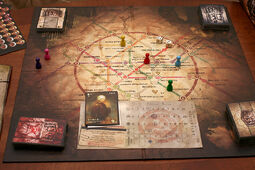
The Metro 2033 Board Game is a board game based on the trials of the player characters, Hunter, Artyom, Miller, Sasha, Anna and Khan each trying to win control of the Metro system. The objective of the game is to capture enough stations and receive a high amount of victory points. The game has a very long and complex set of rules (see below) and is card, stat, and counter based.
The board game and its pieces are currently only in Russian and Polish, with the pricing being around 1,500-2,000 rubles or about 60 - 80 American dollars.
Official Description[]
The "Metro 2033" board game has finally reached Moscow and is now on sale. This article offers an in-depth explanation of the game's complex set of rules.
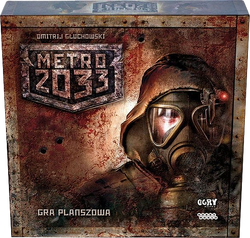
Box of the Polish version
The playing field is a real subway map of the world of the novel, Metro 2033. The game is entirely based on who controls what. One wins by capturing a number of key stations, and earning enough victory points. In addition to the field, there are 49 more cards stations. Each of the stations used in the game has its own picture, and the cards are processed in the style of Fallout and printed on heavier stock.
The concept of card stations is quite simple, in all reality. Some stations (not all, of course) bring you victory points. On the battlefield, possession of the station says "a marker of expansion," the faction for which you are playing. There are six factions in the game, so there may be up to 6 players. The factions are: The Arbat Confederation, the Red Line (Communists), the Fourth Reich (Nazis), organized crime (Bandits), Polis, and the Confederation of 1905. Each faction has its own unique feature of the static, that is permanently valid for this faction.
In addition to images of the station, on the card it is mentioned how many resources it brings to the player (if this station is "active"). The game's mechanics use resource management as an integral part of gameplay. As in the book, the game has three types of resources which are the "mushroom", "bullets" and "pigs." These resources are needed, primarily to supply your team, as well as to buy items and perform various actions on the path to victory. The number of your available resources is also noted on the card token faction. Below is more information about cards factions. On faction cards, as is evident from this figure, there are a few indicators.
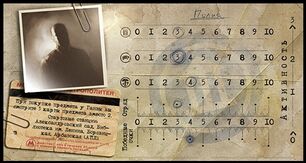
Player Card
The photograph is a "portrait of a hero". Underneath is information on what feature is at your faction. On the right side are the various resources, as already mentioned: mushrooms, cartridges and pigs. Below is the scale, which marks the strength of your army. Further below is the measure of victory points. In the standard game, where there are 3 players, you must score 10 victory points to win. Finally on the far right, is an interesting innovation: the "activity". In many games, a strategy during games in which an odd number of players are active is to let the two players fight, and clean up whatever is left between the two. "Activity" is a small attempt to correct this gap.
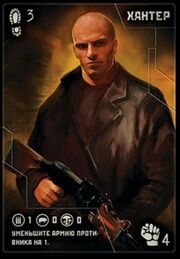
Hunter character card
If you are fighting with another player (it does not matter, win or lose) and get the point of activity, it will prove infinitely useful in future battles. During battles, you must face a so-called "threat", which has a respective card (in the base set of 34 pieces), which are as follows. In the bottom left corner is the power of the threat. To the right of that, in the text box is an extra event that will happen to you if this threat is not eliminated. There are only six heroes: Hunter, Tom, Miller, Sasha, Anna, and Khan. Each of them has its own unique abilities, the number of moves, and lives. Heroes travel independently, separate from a faction's army. A hero can eventually be upgraded, and can be bought items from merchants, the Hansa, which are located on a circular metro line.
Hansa stations, according to the rules of the game are impossible to capture. As a side note, stations who do not have names can also not be captured. For example, you can capture Kiev radial, but can not capture the Ring.
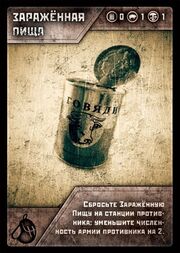
Item Card
Items, mainly used by the hero are always detrimental to the opponent.
Items may be found by stealing, or looting the body. Heroes can walk around the map, and wander into all sorts of dark tunnels and capture stations (neutral and stations of the enemy), and also fight with other heroes. Something that is also used that is quite unique is the addition of "quests".
At the beginning of the game, each player draws three quest-cards. You may choose one of them, but the remaining two must be thrown out. Quests are used as a task for the hero. He may, at a time of the player's choosing, complete it, and then receive an award described on the quest card. This may be victory points, items, weapons, or resources.
